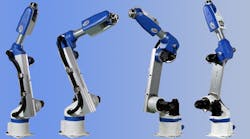What’s the Difference Between Cobots and Industrial Robots?
Upfront Costs
Let’s kick things off with the collaborative robot, or “cobot,” as it is commonly called. The term was coined to represent an unguarded, easy-to-integrate collection of robots that typically carry out repetitive or unsafe tasks while the human workforce performs higher-value manual tasks up- or downstream. In terms of upfront costs, most cobots are cheaper than traditional, industrial robots.
These low costs have provided smaller businesses with accessibility to robots, which in itself is something to be celebrated. However, that doesn’t mean all small businesses need to opt for a cobot to board the automation train.
The alternative is industrial robots. Think SCARA, 6-axis, or cartesian models. These are heavy-duty robots with high payloads that can tackle dangerous, repetitive, and heavy applications. These robots are commonly used for parts assembly, pick-and-place, and palletizing in many different industries—and they have been for decades.
While industrial robots generally cost more upfront, they provide entirely different levels of performance in terms of speed and payload. Cobots follow a safety standard that in short says, the more weight a cobot carries, the slower it should move. In addition, pricing structures are changing, meaning industrial robots are now a becoming more viable option for small businesses. Companies are focused on lower costs, but they are justifying higher price tags by looking at the return on investment (ROI). Industrial robots can perform faster, accomplishing more work in less time, which increases the ROI.
Toshiba Machine’s SCARA robots line, including the newest THE400 range, can provide manufacturers 40% faster speed compared to competing models in this price range.
Cost of Ownership
Whether we’re discussing cobots or industrial robots, a challenge for small to medium sized manufacturers is determining the actual cost of ownership when investing in automation. These are the additional costs of maintenance, energy consumption, and additional equipment requirements that enable the safe usage of the robot.
For example, a risk assessment may determine a cobot needs extra fencing, or force limiters, to use safely alongside humans. This is a very common occurrence for misinformed cobot purchasers. Manufacturers would be forgiven for believing that cobots are automatically safe to use alongside humans, but this isn’t always the case. For example, if a cobot is using an end effector such as a knife, the robot may still require caging.
Cost of energy consumption also needs to be evaluated against the production output. As many cobots are relatively new inventions, many boast low energy consumption. But, you wouldn’t celebrate a cobot only using 800 W of energy if it only outputs one unit during that time. Similarly, you can forgive an industrial robot for using 3,000 W of energy in the same time period if it outputs a large number of units.
Thankfully, many industrial robots now have energy-saving options such as the THL Series.
Programming
In TM Robotics’ Global Robotics Report, some 79% of robot distributors said that simple programming was one of the most important things customers were looking for when purchasing a robot. By nature, cobots are designed for ease-of-use alongside human employees. In fact, one of the most marketed features of these machines is ease of programming.
Easy robot programming is not only an attractive feature for new users; it also provides established users with reduced programming time. Growing demand for easily programmable robots is particularly evident in the rapid increase in sales of collaborative models.
Some cobots are known for their easy-to-use, intelligent, hand-guided teaching ability, where the operator simply teaches a cobot a new program by moving the robot manually. On the other hand, industrial robots have developed reputation of being labor-intensive in relation to programming. However, this is not always the case.
We’re witnessing a shift in behavior from robot manufacturers in favor of easy-to-program industrial robots. This is particularly advantageous for small- to medium-sized businesses that are perhaps new to automation, but don’t have the expertise in house for complex programming.
There’s an argument for both industrial robots and cobots, but the decision on which to select depends on the application. While industrial robots are shifting some longstanding misconceptions on programmability and costs, the collaborative robot is also being held to higher standards in relation to ROI and productivity.
There’s space on the market for both industrial robots and cobots. The question is, which one is worth your investment?
Nigel Smith is president and CEO of Toshiba Machine partner TM Robotics.



